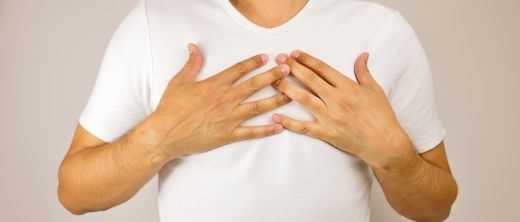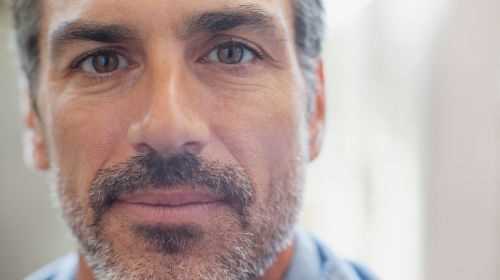If men have unilateral or bilateral breasts, there can be different reasons. What the causes may be, what helps and what the prognosis is.
Gynecomastia results in benign growth of the mammary gland, while so-called pseudogynecomastia (lipomastia) is caused exclusively by the increased formation of fatty tissue in the breast area. Both types of male breasts are very uncomfortable for most of those affected and sometimes cause great shame. In some phases of life, gynecomastia is completely normal due to hormonal changes, pseudogynecomastia usually occurs in people who are very overweight.
Article content at a glance:
What is gynecomastia?
The term gynecomastia describes a benign enlargement of the mammary glands in males. The growth can occur on one or both sides, and with or without pain. Due to natural hormone shifts, gynecomastia often occurs immediately after birth, during puberty and in old age.
A distinction must be made between real gynecomastia and pseudogynecomastia. Both types are difficult to distinguish from one another in terms of their visual appearance, and mixed forms often occur.
Gynecomastia: It is an enlargement of the male breast due to the proliferation of the glandular tissue. In most cases, fatty tissue is also deposited around the enlarged breast, regardless of the total body weight or existing excess weight. The extent of gynecomastia is very variable and can vary from a slight increase in volume behind the nipple to woman-like sagging breasts with strongly stretched nipples, significant excess skin and considerable amounts of fatty and glandular tissue.
Pseudogynecomastia (Lipomastia): In pseudogynecomastia, there is an increased storage of fatty tissue in the male breast, the mammary gland tissue does not change. The accumulations of fat are usually caused by excessive weight (obesity), but in rare cases can also be caused by tissue tumors (lipomas).
What are the causes of gynecomastia?
In most cases, hormone fluctuations lead to excessive growth of the mammary gland. Non-pathological gynecomastia is caused by the excess weight of naturally occurring female hormones (estrogens) in the male body. In the case of newborns, these come from the mother. During puberty, more estrogens are formed, which can temporarily lead to an imbalance with the male hormones (testosterone). In advanced adulthood, on the other hand, gynecomastia is usually triggered by age-related decreased testosterone production. Since fewer male sex hormones are built up, there is a relative excess of female hormones.
But there are also other causes that can cause a pathological hormonal imbalance and thus gynecomastia. These are:
hormone-producing tumors, especially of the testicles, adrenal glands or pituitary glands
decreased testosterone production due to various diseases of the testes
Diseases such as cirrhosis of the liver, hyperthyroidism, obesity, kidney failure
therapeutic delivery of estrogens
Drugs such as spironolactone, cimetidine, ranitidine, omeprazole, ketotonazole, bicalutamide, finasteride, diazepam, nifedipine, digitoxin, captopril, enalapril, amiodarone
Use of drugs such as alcohol, heroin, methadone, marijuana, and amphetamines
Doping with anabolic-androgenic steroids, for example in bodybuilding
Environmental and nutritional influences, for example from soy milk, soaps and shampoos with lavender or tea tree oil additives, phytoestrogens, isoflavones or hormone-containing hair restorers
mechanical influences such as sustained pressure or friction
Chromosomal abnormalities (for example, Klinefelter syndrome)
familial or inherited gynecomastia of unknown origin
What are the symptoms of gynecomastia?
Gynecomastia can only manifest itself as an increase in the size of the male breast or both mammary glands, without causing any other physical symptoms. In many cases, however, the nipple and areola are enlarged and sensitive to touch. The enlarged glandular tissue is often palpable in strands, can be easily moved on the chest muscles and can be very sensitive to pressure. It can lead to a feeling of tension and restricted mobility; in rare cases, a milky fluid is secreted from the nipple (galactorrhea).
Many sufferers suffer from considerable psychological pressure, which can be traced back to the cosmetically disruptive enlargement of the male breasts. In very pronounced cases, when the appearance of gynecomastia is very similar to that of a female breast, young men in particular try to hide their bodies. They avoid wearing tight-fitting outer clothing, change their posture, avoid swimming pools or other sporting activities and withdraw from social life.
Diagnostics for gynecomastia
To diagnose gynecomastia, a man should first visit the family doctor. Usually a specialist in internal medicine, endocrinology, andrology and urology or, in the case of boys, a pediatrician takes care of the further diagnosis.
Gynecomastia can usually be identified by a detailed medical history and thorough physical examination. It then mainly consists of palpating the man’s breast. It can also be felt whether the structure and shape of the glandular body may indicate malignant growth.
In order to confirm the diagnosis, to assess suspicious glandular tissue more precisely or to search for malignant tumors, ultrasound examinations of the breast, mammograms, x-rays, computed tomography or magnetic resonance examinations of the chest can be helpful. Possible triggering causes are looked for through blood tests (hormone status, liver and kidney values), ultrasound and palpation examinations of the testicles, chromosome analyzes and fine-tissue examinations of the mammary gland tissue.
How can you treat gynecomastia?
Whether and how gynecomastia is treated depends on the cause and severity. If, for example, it is a question of gynecomastia during puberty, no treatment is necessary, as the man’s breast usually regresses on its own in these cases.
However, if a cause for the enlargement of the male breast can be found, the treatment approaches aim to eliminate the trigger and to rebalance the hormonal balance. Causing drugs must be discontinued or replaced, diet changed, and hidden external sources of estrogen identified and eliminated. If there is a causative underlying disease, the focus is on treating it.
If this does not lead to the desired success, attempts can be made to intervene in the hormonal balance with medication. This is done either through the direct administration of testosterone or the use of anti-estrogen drugs such as tamoxifen. However, this hormone therapy is very controversial, has many side effects and only really promises to be successful in the first few months of the mammary gland growth.
Breast reduction for gynecomastia
Complete correction of the man’s breast can only be done through surgical intervention. In most cases, the surgical removal of the enlarged glandular tissue is combined with conventional liposuction. Sometimes liposuction alone can be enough. The operation is usually performed under general anesthesia. After the breast reduction, sufferers must wear a compression garment day and night for six weeks to promote healing. Sport and vigorous physical exertion must be avoided for about a month.
Statutory and private health insurances rarely cover the costs. If there is no compelling medical indication for an operation, the operation costs of around 2,500 euros or more must be paid by the person concerned.
What can you do if you have gynecomastia?
Since in most cases of gynecomastia there is also storage of fatty tissue in the breasts, targeted endurance and strength training can lead to a reduction in body fat and thus also to a reduction in breast fat. Especially with special chest muscle training you can partially train the man’s chest away.
A healthy diet and the avoidance of alcohol also mean that an increased body fat percentage is reduced in the long term and the excess fat in the breasts disappears.
Course and prognosis
In many cases, gynecomastia is not pathological and only needs to be treated if the psychological pressure becomes too stressful for the person concerned.
As in women, the male glandular tissue can change and lead to breast cancer. Although this is significantly less common than in women, gynecomastia should be examined by a doctor to rule out breast cancer.
.


